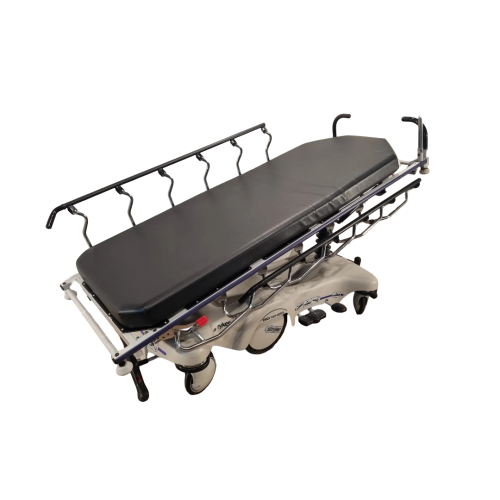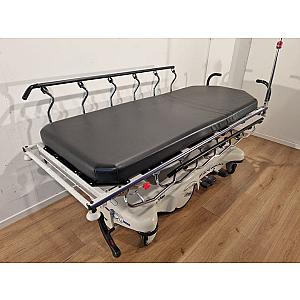The Stryker 1501 Big Wheel stretcher is designed to meet the demands of modern medical environments, combining robustness, manoeuvrability and patient comfort. Thanks to its double-column hydraulic system and Big Wheel option, it offers improved mobility and ergonomic handling. Suitable for post-anaesthetic care (PACU), transport and emergencies, this stretcher guarantees safety, efficiency and flexibility for healthcare professionals.
1501 Big Wheel Stretcher - Perfect Condition





Description
Stryker 1501 Big Wheel Stretcher: Versatility and Optimised Mobility for Hospital Care
The Stryker 1501 Big Wheel stretcher embodies excellence in patient transport and care in medical facilities. Designed for post-anaesthesia care units (PACUs), emergency departments and intra-hospital transfers, this model stands out for its robustness, ease of use and optimal patient comfort.
At the heart of its design is a dual-column hydraulic system that allows for smooth and precise adjustments of the stretcher height as well as Trendelenburg and Reverse Trendelenburg positions. These adjustments are accessible via side or end pedals, providing maximum ergonomics for caregivers regardless of their position around the stretcher.
The Big Wheel option is a major advantage of the 1501 model. It significantly improves the traction and steering of the stretcher, particularly in crowded environments or on uneven surfaces. When directional mode is activated, the foot castors are slightly raised, allowing the stretcher to rest on the two large fixed wheels and the head castors, ensuring increased manoeuvrability and reducing the physical effort required for movement.
Patient comfort and safety are also key considerations. The stretcher is equipped with easy-to-operate Glideaway™ side rails, steel ring brakes on all four wheels with activation at both ends, and rubber bumpers to protect surrounding surfaces. It also has four receptacles for IVs, an integrated storage tray with oxygen bottle holder, and an 8 cm thick mattress for optimal support.
The stretcher frame allows for full articulation of the backrest (up to 90°) and leg rest (up to 35°), facilitating care and examinations. It can be equipped with various accessories depending on clinical needs: X-ray cassette holder, heel stirrups, removable push bars, and different types of mattresses for personalised comfort.
The 1501 Big Wheel model is built to last, with a load capacity of 227 kg and a robust construction suitable for intensive use. It meets the most stringent safety and performance standards, making it the preferred choice for healthcare facilities concerned with quality of care and operational efficiency.
Features
- Dual-column hydraulic system for Hi-Low and Trendelenburg adjustments
- Side and end control pedals
- Big Wheel option for better traction and steering
- Glideaway™ side rails with secure locking mechanism
- Steel ring brakes on all four wheels
- Rubber bumpers for surface protection
- Built-in storage tray with oxygen bottle holder
- Four IV pole holders
- Standard 8 cm thick mattress
- Robust structure for intensive use
Technical Details
- Maximum capacity: 227 kg (500 lb)
- Total length: 211 cm (83")
- Total width with raised barriers: 86 cm (34")
- Total width with side rails lowered: 77 cm (30.5")
- Patient surface area: 66 x 193 cm (26" x 76")
- Minimum height: 56 cm (22")
- Maximum height: 90 cm (35.5")
- Caster diameter: 20 cm (8")
- Backrest angle: 0° to 90°
- Leg rest angle: 0° to 35°
- Trendelenburg/Reverse Trendelenburg position: +12° to -18°
Compatible Accessories
- X-ray cassette holder
- Heel stirrups
- Removable push bars
- Retractable handles
- Comfort mattress (3", 4", 5")
- Defibrillator tray
- Service tray/instrument tray
- Patient restraint straps
- IV caddy
- IV poles (2 or 3 levels, fixed or removable)
- Vertical oxygen cylinder holder
- Wheel covers
- Extendable footrest